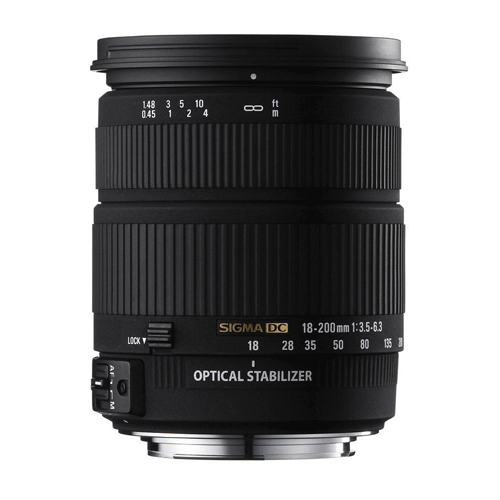Sigma 18-200mm f/3.5-6.3 DC OS
 |
| Gary Wolstenholme takes a look at Sigma's optically stabilised 18-200mm lens. |
Sigma's 18-200mm f/3.5-6.3 DC OS costs around £290 and sports an 11.1x zoom ratio and optical stabilisation. Sigma also make an 18-250mm f/3.5-6.3 lens, which costs around £400 and adds 50mm to the telephoto reach, making it a better specified, yet more expensive alternative.
The lens is available to fit Canon and Nikon cameras and both manufacturers make suitable alternatives. Nikon users have the choice of Nikon's 18-200mm f/3.5-5.6 AF-S DX ED VRII, which costs around £550 but adds a silent focusing motor and has a brighter maximum aperture at the telephoto end. Canon users also have another 18-200mm to choose from. Their EF-S 18-200mm f/3.5-5.6 IS USM lens has a similar spec to the Nikon optic and costs around £370.
Tamron offer a couple of different lenses in this range. The basic 18-200mm f/3.5-6.3 XR DiII lens can be purchased for around £170 but lacks optical stabilisation. The 18-270mm f/3.5-6.3 DiII VC LD does have vibration compensation and adds 70mm to the telephoto reach, but costs around £400.
Sigma 18-200mm f/3.5-6.3 DC OS: Handling and features
At 100mm long and with a diameter of 79mm, this 18-200mm is a little chunkier than your standard kit zoom, and weighing 610g it is a fair bit heavier too. This is to be expected when the huge zoom range is considered and also the build quality, which is better than you'd expect on many third party lenses of this ilk. High quality plastics have been used throughout and an attractive matt powder coating has been applied to some external parts, which finishes the lens off rather nicely. I did notice that this coating does mark easily though, showing marks from simply being removed from and inserted into a padded bag.
An internal motor powers autofocus, but is isn't one of those fancy silent ones found on Sigma's HSM lenses. As a result focusing isn't as quick as it could be, especially at the longer end of the range, and it makes slight grinding noise. The noise isn't overly disturbing though, and I soon got used to it.
The zooming action is pretty smooth, only tightening slightly at the wide end and the lens extends in two sections, almost doubling in length at maximum telephoto. The fit and finish of the lens barrel is very good, with no wobbles or creaks to report. During autofocus the focus ring whizzes back and forth as the lens locks on. It would've been nice to be able to disengage this during AF as I sometimes found it would catch my fingers.
Sigma's optical stabiliser system promises to allow sharp shots to be taken hand held at shutter speeds up to four stops slower than would be possible without help. This is a necessity with the slow maximum aperture of f/6.3 at 200mm in my opinion. I was able to take sharp shots with some degree of consistency hand held at shutter speeds as low as 1/20sec at 200mm. This is roughly four stops slower than the usual rule of thumb would allow.
Sigma 18-200mm f/3.5-6.3 DC OS: Performance
Lenses with a high zoom range like this Sigma are often a compromise of convenience over quality. Saying that, compared to other lenses of this type that I've used, the Sigma 18-200mm isn't a bad performer.
At 18mm and f/3.5 the resolution in the centre is already very good and the quality towards the edges is adequate. Stopping down improves the quality further and peak performance is achieved between f/5.6 and f/8, where the sharpness in the centre is excellent and very good towards the edges of the frame.
Zooming to 80mm causes a slight drop off in performance, but at maximum aperture the sharpness in the centre is still pretty good and the quality towards the edges is fair. Peak quality for this focal length is achieved at f/11, where the centre resolution is still good and the quality towards the edges isn't too far behind.
At 200mm, the performance in the centre and towards the edges trade places. At f/6.3 the quality towards the edge is approaching good and the centre is fair. Peak quality across the frame is achieved at f/16 for this focal length, where the sharpness across the frame approaches good levels.
Chromatic Aberrations towards the edges of the frame can be quite prevalent, especially along high contrast edges. Imatest recorded values exceeding one pixel width at 200mm when the lens is stopped down.
Falloff of illumination towards the corners isn't really much of an issue with this lens. At 18mm and f/3.5 the corners are only 1.2stops darker than the image centre and stopping down t f/5.6 results in visually uniform illumination. At 200mm the level of falloff decreases slightly, with the corners being 0.82stops darker than the image centre. Here stopping down to f/8 results in visually uniform illumination.
As is common with high ratio zooms such as this, distortion at the wide end is quite pronounced. Here Imatest recorded 6.19% barrel distortion, which may pose issues if straight lines are important in your images. At 200mm 1.04% pincushion distortion has replaced the barrelling and should pose fewer issues. Luckily the distortion pattern is uniform across the frame, so correcting images in image editing software afterwards should be fairly straightforward.
Care may need to be taken when using this lens with the sun in the frame as the lens is fairly susceptible to flare at the wide end. At telephoto focal lengths a loss of contrast should be the worst you will encounter with light sources in the frame. A petal shaped lens hood come supplied with the lens, which does a decent job of shielding the lens from light sources out of the frame at shorter focal lengths. Unfortunately it isn't quite deep enough to provide adequate shade for the telephoto end, which is a compromise to be made with having such a high zoom range.
Sigma 18-200mm f/3.5-6.3 DC OS: Verdict
I have to admit, I'm not normally a fan of high zoom ratio lenses due to the compromises involved. Saying that, this lens is a decent performer for this kind of lens and should please many users looking for convenience for travel or casual photography.
The optical stabiliser also works really well and adds to the value of the lens. At £290 it doesn't cost a fortune, making the lens a pretty good value choice.
Sigma 18-200mm f/3.5-6.3 DC OS: Pros
 High zoom range
High zoom range Decent sharpness at shorter focal lengths
Decent sharpness at shorter focal lengths Highly effective optical stabiliser
Highly effective optical stabiliser Price
PriceSigma 18-200mm f/3.5-6.3 DC OS: Cons
 Falloff in sharpness at 200mm
Falloff in sharpness at 200mm CA towards edges can be noticeable along high contrast edges
CA towards edges can be noticeable along high contrast edges Slow AF at telephoto end.
Slow AF at telephoto end.| FEATURES |  |
| HANDLING |  |
| PERFORMANCE |  |
| VALUE FOR MONEY |  |
| OVERALL |  |
Sigma 18-200mm f/3.5-6.3 DC OS: Lens specification
| Price | £290.00 |
| Contact | www.sigma-imaging-uk.com |
| Filter size | 72mm |
| Format | APS-C |
| Construction | 69.3 - 7.1 degrees |
| Angle-of-view | 72.4° - 20.2° |
| 35mm equivalent focal length (on APS-C body) | 27-300mm |
| Internal focusing | Yes |
| Image stabilisation | Yes |
| Minimum focus | 45cm |
| Maximum aperture | f/3.5-6.3 |
| Minimum aperture | f/22-40 |
| Weight | 610g |
| Size | 79mm x 100mm |
| In the box | Lens Case, Lens Hood |
The Sigma 18-200mm f/3.5-6.3 DC OS costs around £290 and is available from Warehouse Express here:
Sigma 18-200mm f/3.5-6.3 DC OS for Canon
Sigma 18-200mm f/3.5-6.3 DC OS for Nikon
Sigma 18-200mm f/3.5-6.3 DC OS for Sigma
Add your message
Login required
Please login here or if you've not registered, you can register here. Registering is safe, quick and free.
Please login here or if you've not registered, you can register here. Registering is safe, quick and free.
photodo Stats
1102 lenses
428 MTF tests
74 in-depth photodo reviews
100+ users join each day
Help the lens community by reviewing or rating a lens today via our lens search
428 MTF tests
74 in-depth photodo reviews
100+ users join each day
Help the lens community by reviewing or rating a lens today via our lens search
Latest Lens Reviews
- Chinon 28mm f/2.8 Vintage Lens Review
- Canon EF 70-200mm f/4L IS II USM Lens Review
- Samyang AF 85mm f/1.4 EF Review
- Sigma 70mm f/2.8 DG Macro Art Review
- Samyang AF 24mm f/2.8 FE Review
- Meike 50mm f/1.7 Review
- Tamron 70-210mm f/4 Di VC USD Review
- Lensbaby Burnside 35mm f/2.8 Review
- Asahi Super Takumar 50mm f/1.4 Review
- Asahi Super-Multi-Coated Takumar 135mm f/3.5 Review








